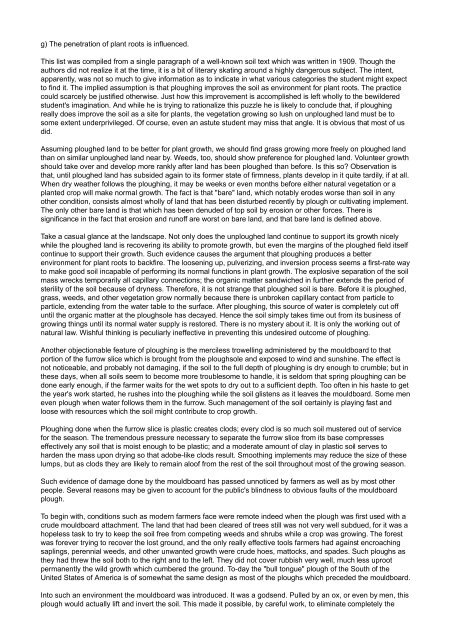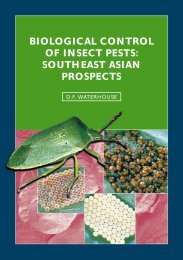Ploughman's Folly Ploughman's Folly - EcoPort
Ploughman's Folly Ploughman's Folly - EcoPort
Ploughman's Folly Ploughman's Folly - EcoPort
You also want an ePaper? Increase the reach of your titles
YUMPU automatically turns print PDFs into web optimized ePapers that Google loves.
g) The penetration of plant roots is influenced.<br />
This list was compiled from a single paragraph of a well-known soil text which was written in 1909. Though the<br />
authors did not realize it at the time, it is a bit of literary skating around a highly dangerous subject. The intent,<br />
apparently, was not so much to give information as to indicate in what various categories the student might expect<br />
to find it. The implied assumption is that ploughing improves the soil as environment for plant roots. The practice<br />
could scarcely be justified otherwise. Just how this improvement is accomplished is left wholly to the bewildered<br />
student's imagination. And while he is trying to rationalize this puzzle he is likely to conclude that, if ploughing<br />
really does improve the soil as a site for plants, the vegetation growing so lush on unploughed land must be to<br />
some extent underprivileged. Of course, even an astute student may miss that angle. It is obvious that most of us<br />
did.<br />
Assuming ploughed land to be better for plant growth, we should find grass growing more freely on ploughed land<br />
than on similar unploughed land near by. Weeds, too, should show preference for ploughed land. Volunteer growth<br />
should take over and develop more rankly after land has been ploughed than before. Is this so? Observation is<br />
that, until ploughed land has subsided again to its former state of firmness, plants develop in it quite tardily, if at all.<br />
When dry weather follows the ploughing, it may be weeks or even months before either natural vegetation or a<br />
planted crop will make normal growth. The fact is that "bare" land, which notably erodes worse than soil in any<br />
other condition, consists almost wholly of land that has been disturbed recently by plough or cultivating implement.<br />
The only other bare land is that which has been denuded of top soil by erosion or other forces. There is<br />
significance in the fact that erosion and runoff are worst on bare land, and that bare land is defined above.<br />
Take a casual glance at the landscape. Not only does the unploughed land continue to support its growth nicely<br />
while the ploughed land is recovering its ability to promote growth, but even the margins of the ploughed field itself<br />
continue to support their growth. Such evidence causes the argument that ploughing produces a better<br />
environment for plant roots to backfire. The loosening up, pulverizing, and inversion process seems a first-rate way<br />
to make good soil incapable of performing its normal functions in plant growth. The explosive separation of the soil<br />
mass wrecks temporarily all capillary connections; the organic matter sandwiched in further extends the period of<br />
sterility of the soil because of dryness. Therefore, it is not strange that ploughed soil is bare. Before it is ploughed,<br />
grass, weeds, and other vegetation grow normally because there is unbroken capillary contact from particle to<br />
particle, extending from the water table to the surface. After ploughing, this source of water is completely cut off<br />
until the organic matter at the ploughsole has decayed. Hence the soil simply takes time out from its business of<br />
growing things until its normal water supply is restored. There is no mystery about it. It is only the working out of<br />
natural law. Wishful thinking is peculiarly ineffective in preventing this undesired outcome of ploughing.<br />
Another objectionable feature of ploughing is the merciless trowelling administered by the mouldboard to that<br />
portion of the furrow slice which is brought from the ploughsole and exposed to wind and sunshine. The effect is<br />
not noticeable, and probably not damaging, if the soil to the full depth of ploughing is dry enough to crumble; but in<br />
these days, when all soils seem to become more troublesome to handle, it is seldom that spring ploughing can be<br />
done early enough, if the farmer waits for the wet spots to dry out to a sufficient depth. Too often in his haste to get<br />
the year's work started, he rushes into the ploughing while the soil glistens as it leaves the mouldboard. Some men<br />
even plough when water follows them in the furrow. Such management of the soil certainly is playing fast and<br />
loose with resources which the soil might contribute to crop growth.<br />
Ploughing done when the furrow slice is plastic creates clods; every clod is so much soil mustered out of service<br />
for the season. The tremendous pressure necessary to separate the furrow slice from its base compresses<br />
effectively any soil that is moist enough to be plastic; and a moderate amount of clay in plastic soil serves to<br />
harden the mass upon drying so that adobe-like clods result. Smoothing implements may reduce the size of these<br />
lumps, but as clods they are likely to remain aloof from the rest of the soil throughout most of the growing season.<br />
Such evidence of damage done by the mouldboard has passed unnoticed by farmers as well as by most other<br />
people. Several reasons may be given to account for the public's blindness to obvious faults of the mouldboard<br />
plough.<br />
To begin with, conditions such as modern farmers face were remote indeed when the plough was first used with a<br />
crude mouldboard attachment. The land that had been cleared of trees still was not very well subdued, for it was a<br />
hopeless task to try to keep the soil free from competing weeds and shrubs while a crop was growing. The forest<br />
was forever trying to recover the lost ground, and the only really effective tools farmers had against encroaching<br />
saplings, perennial weeds, and other unwanted growth were crude hoes, mattocks, and spades. Such ploughs as<br />
they had threw the soil both to the right and to the left. They did not cover rubbish very well, much less uproot<br />
permanently the wild growth which cumbered the ground. To-day the "bull tongue" plough of the South of the<br />
United States of America is of somewhat the same design as most of the ploughs which preceded the mouldboard.<br />
Into such an environment the mouldboard was introduced. It was a godsend. Pulled by an ox, or even by men, this<br />
plough would actually lift and invert the soil. This made it possible, by careful work, to eliminate completely the






